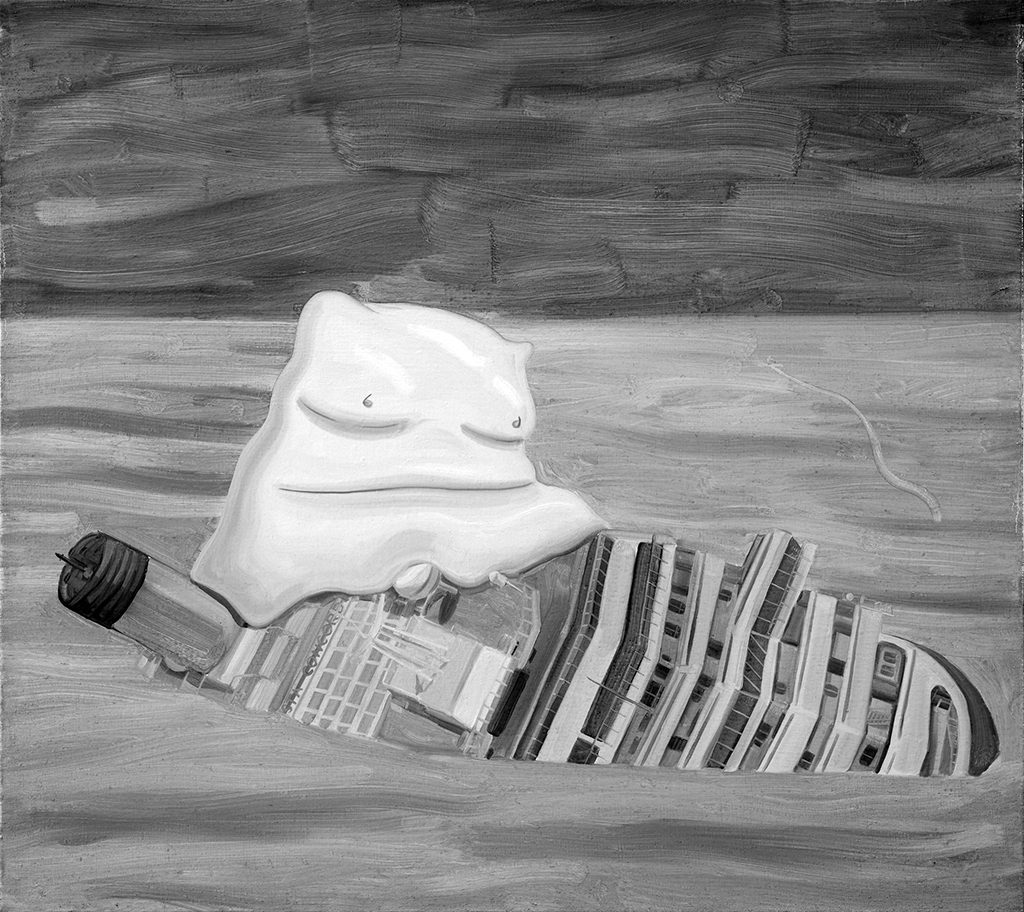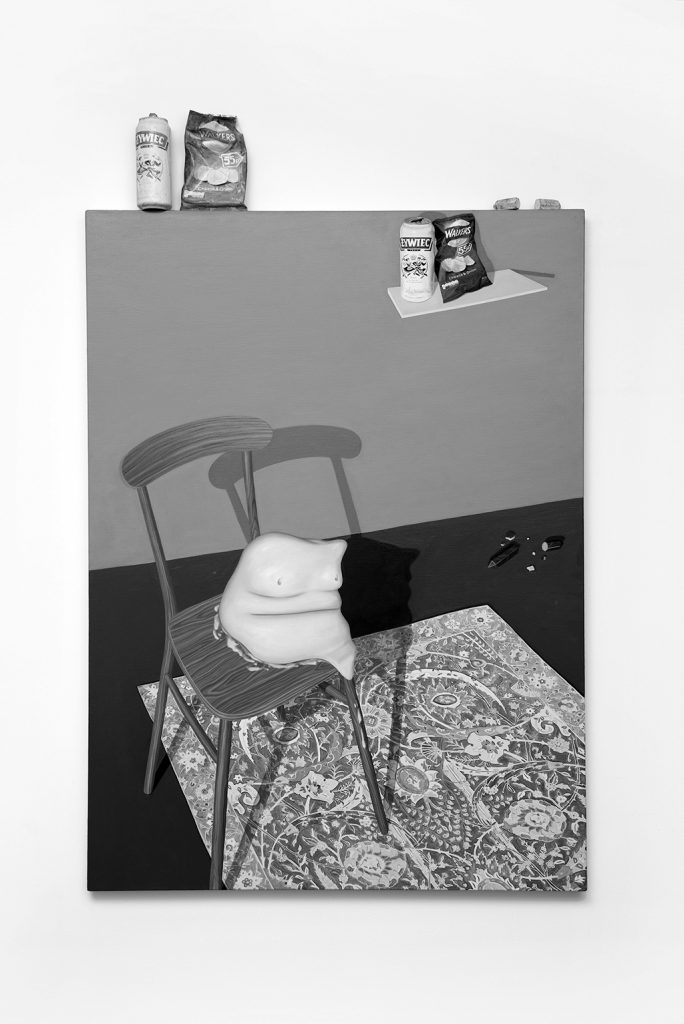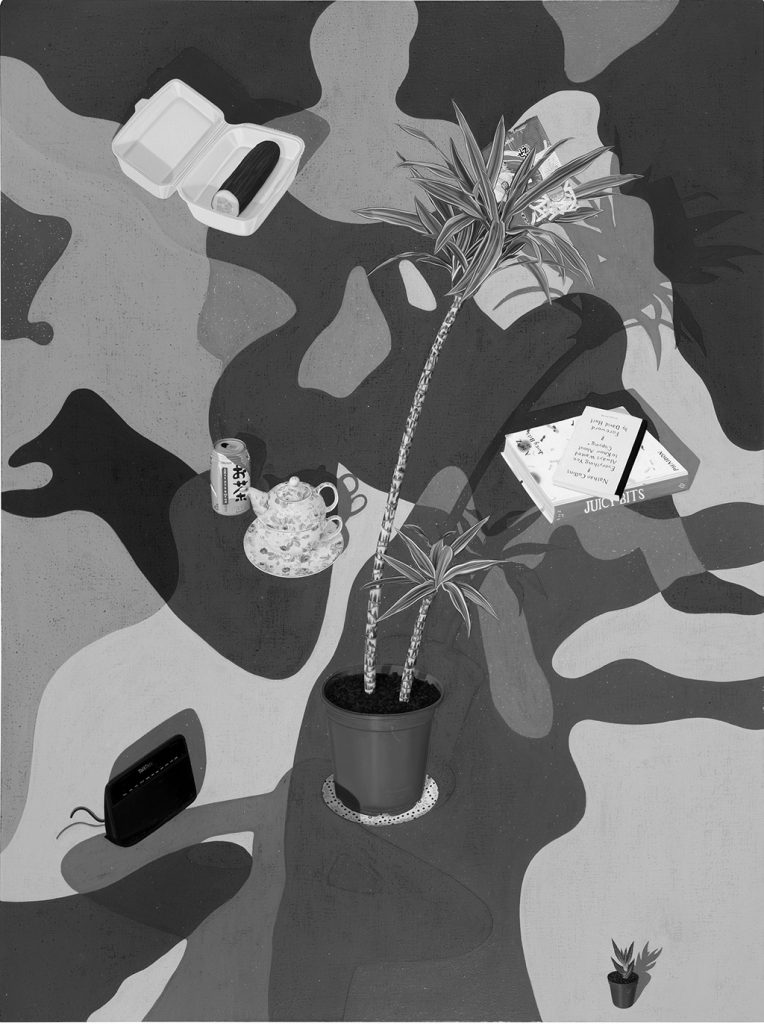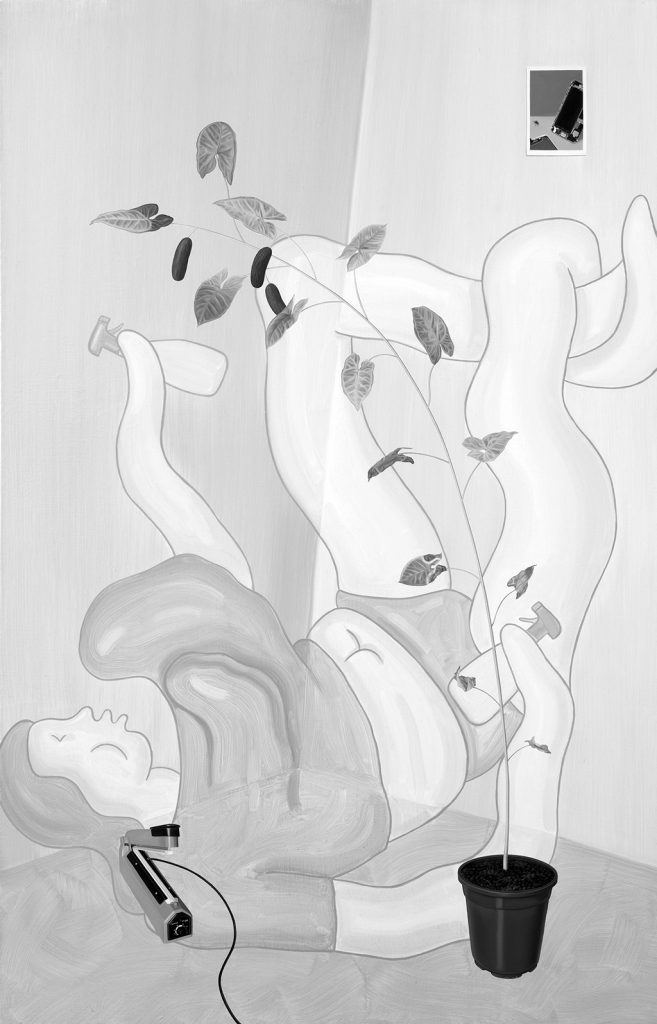A New Visual Code
Tristan Pigott: Juicy Bits
Cob Gallery, London
08.06.17 – 01.07.17
1. In her essay ‘In Plato’s Cave’ ( 1977 ), Susan Sontag is emphatic: photographs alter our understanding of what is worthy of our gaze. In fact, in 1839, the year that practical photography was introduced to the mass market to riotous response, we began to operate with ‘a new visual code’. Sontag continues: ‘The most grandiose result of the photographic enterprise is to give us the sense that we can hold the whole world in our heads – as an anthology of images.’ Important, here, is the deliberate ambiguity. Watch this phrase, ‘to give us the sense’. For while we have always operated under the naive illusion that our anthology is something close to boundless, its contents have always been at the mercy of regulation, convention and context – as they invariably will be. It’s Truman Show ( 1998 ) logic: ‘Boy, take a look at that horizon!’ Then the boat pierces the wall.
2. How wide is today’s ‘whole world’? How comprehensive the ‘anthology’, when images and information circulate in greater quantities, at greater velocities, than ever before?1 Not so wide, and not so comprehensive! For now, in addition to those preexisting forms of censorship and streamlining, we have digital technology to contend with. Now we have algorithms, cookies, caches; consumer surveillance; the re-targeting of cookies: those unseen henchmen that ensure we see far more than we can ever digest, but far less at the same time.
This repetition, this imposed scroll/swipe systematisation and the related consumption of content, have led to an internalised form of fatigue that not only alters the manner in which we consume, but also the ways in which we produce. With few alternative sources left, we acclimatise to relentless repetition and, thereafter, unconsciously reproduce – once, twice, thrice, ad infinitum.2 As selfie breeds selfie, landscape breeds landscape, avocado breeds avocado,3 I tentatively propose that we are returning to a lost era of machine art. For today, Marshall McLuhan’s oft-quoted proposition that technology represents an extension of ‘man’ seems foggy. Might ‘man’ have become an extension of technology? Telling is the epigraph-cum-epitaph of Ezra Pound’s Machine Art and Other Writings: The Lost Thought of the Italian Years: ‘For every thinking which is lost’.4
3. Somewhere in the throes of this techno-lethargy, as user is recast as ‘account holder’, we find Tristan Pigott’s oil paintings – paintings that are fucking tired of it all. There is something undeniably ‘Instagramish’ about these works, currently on view at North London’s Cob Gallery under the title Juicy Bits. An attractive runner sports fresh lemon and moss Lycra; an attractive twenty-something slouches over a MacBook, Rodin’s Thinker in a ‘post-internet’ age; an attractive ( they’re all attractive ) rocker crouches against a wall, legs wrenched to an unrealistic, yet aesthetically desirable, angle. With neck craned, eyes wandering and bleached denim scuffed, our young cad is backed by his gloopy, green visualisation of how this scene might roll out online: free, formless, with no indication that it was choreographed with precision.
Following suit, the accoutrements encircling these figures also conform to social media’s silver standards. In the titular Juicy Bits ( 2017 ), we find a psychedelic still life, curated to cultivate online attention: flourishing plant life; remnants of take-away food; a can of imported tea; an ad hoc arrangement of coffee-table books ( one titled Everything You Always Wanted to Know About Copying ). Over it all floats the shadow of the photographer, whose personality dissolves into, and is defined by, the dislocated mise-en-scène below.
4. These thematic banalities are spewed riotously across Pigott’s paintings – excuse the phrase, my dear, but these are the ‘Juicy Bits’, after all; the bite-size rundowns of content that we have been conditioned to consume – regurgitate – spit out. Here, however, clickbait cliché and app-centric ideology warp and melt in a manner that unveils their sheer vapidity. The fastest food, the quickest fuck, the most futile of middle-class fantasies: they’re all here, battered, bent out of proportion and left badly bruised.

Tristan Pigott, Captain as Lard , 2017, oil on linen, 80 x 90 cm. Courtesy the artist and Cob Gallery, London. Photo © the artist and Cob Gallery, London. 图片由艺术家和伦敦Cob 画廊提供.
Special attention is paid to masculinity, that font of more injustice than we have time to unpack here ( there, anywhere ). On a wooden chair sits the very same fetishised ( white ) torso that has condemned us all ( me ) to a long, cumbersome life of awkwardly donning swimwear beneath a beach towel. Here, however, it is limbless and globular, dripping like a libidinal ball of lard onto a rendering of a Persian rug that in 2013 fetched an ostentatious $34 million at auction.5 The heft returns in Captain as Lard ( 2017 ). ( Imagery hops between Pigott’s paintings, mimicking the quick-fire photographs that blurrrr beneath our disinterested thumbs. ) Here, he dribbles, content, atop the semi-submerged Costa Concordia cruise ship, which in 2012 sunk to the depths after its captain tried to wave to a friend on the shore. That’s masculinity for you. Not a rippling six-pack with 50k+ followers, but a congealed, drizzling blob, making a mess of everything beneath.
5. Pigott’s works are less photorealistic representations of a tangible demographic ( the often-criticised, always-feared ‘youth’ ) than they are visualisations of a technologically-birthed phenomenon of distraction and dislocation from the ( old ) world. This is reason enough to deem Juicy Bits a biting denunciation of our time. But to deem it such would be completely to miss the mark. For while these paintings are appropriate tropes of ( and, yes, batter ) the Instagram-age, they do so in a manner that: a. acknowledges the artist’s complicity in the act and b. revels in the joyous, the loopy, the lovable. Vast, perspectiveless backcloths of block colour warp and whack us out of joint; ghostly figures gargle in the wings, chiselling, watering plants, melting things to a pulp. Glorious non sequitur rules the waves: TalkTalk router plus teapot; broken iPhone plus heat sealer; painting-by-numbers kit plus cucumber.

Tristan Pigott, Artist as Medium , 2017, oil on crisp packet, oil on beer can, papier mâché, oil on linen, 140 x 95 cm. Courtesy the artist and Cob Gallery, London. Photo © the artist and Cob Gallery, London. 图片由艺术家和伦敦Cob 画廊提供
But before you term these wacky non-worlds the stuff of ‘pop surrealism’, or something equally as ungainly, note that these objects, upon which this peculiarity is assembled, are drawn from reality! Pigott does not summon these scenes from nothingness. Instead, he plucks preexisting mundanities, renders them bizarre, exuberant, and in doing so offers a much-needed reminder that we can still mine pleasure in the unpleasurable – unremarkable – unfashionable. Life continues beyond the square borders of an Instagram post, beyond the frame of a ripped YouTube clip, beyond the 13.3-inch LED-backlit display of your MacBook Pro, and you can still enjoy that. Put a router next to a teapot. Put a painting-by-numbers kit next to a cucumber. You can find what you’re looking for out there, offline, ‘IRL’; you just need to reconsider what you’re looking at. You just need a new visual code,
to give us the sense
of fatigue
these
sports fresh
still
are spewed
down
Here
like
at auction
a friend
out of joint
plucks
the square borders
You
You’re looking
1. At the time of writing ( 20:46 CET, Sunday 24 September ), 18,533,915,410 photographs have been uploaded to Instagram in 2017; 1,634,093,954,072 videos have been viewed on YouTube; 62,944,203,839,264 emails have been sent. These figures are lifted from Internet Live Stats, and are now redundant.
2. Interesting, here, is Silicon Valley billionaire Peter Thiel’s long-standing interest in the French philosopher René Girard – crucially, his 1978 book, Things Hidden since the Foundation of the World. Girard termed his central hypothesis ‘mimetic desire’, the notion that, as Thiel summarises it, ‘imitation is at the root of all behaviour’ ( John Lanchester, ‘You Are the Product’, London Review of Books, vol. 39, no. 16, 17 August 2017 <https://www.lrb.co.uk/v39/n16/john-lanchester/you-are-the-product> ). Also interesting is Nicholas Carr in ‘The Bookless Library’: ‘it’s hard not to conclude that as we adapt to the intellectual environment of the Net our thinking becomes shallower’ ( Nicholas Carr, ‘The Bookless Library’, in How is the Internet Changing the Way You Think?: The Net’s Impact on Our Minds and Future, ed. John Brockman, Atlantic Books, London, 2011, p. 3 ).
3. At the time of writing ( 20:49 CET, Sunday 24 September ), the hashtag #avocado has been used 6,651,256 times on Instagram; #avocadotoast: 524,829; #avocados: 260,337. These figures are now redundant.
4. Ezra Pound, Machine Art and Other Writings: The Lost Thought of the Italian Years, ed. Maria Luisa, Duke University Press, Durham NC, 1996.
5. The price paid for the item in question, which had previously belonged to the William A. Clark Collection, was more than three times the previous record price paid for a rug. A CNN iReport of the event ( <http://ireport.cnn.com/docs/DOC-990457> ) claims that, upon the close of the sale, ‘the entire room erupted into a cathartic and beautiful applause’.
新视觉代码
《Tristan Pigott: 多汁的比特》
Cob 画廊,伦敦
2017 年6 月8 日 – 2017 年7 月1 日
译/ 顾虔凡
苏珊· 桑塔格在她的文章《在柏拉图的洞穴里》( 1977 ) 中断言强调:照片改变了我们对什么事物值得凝视这一问题的理解。事实上,在1839 年,实用的摄影术被引荐到大众市场而受到狂热回应的那一年,我们就开始了“一种新视觉代码”的运行。桑塔格还说道:“摄影业所带来的最辉煌的成果,是给我们这样一种感受, 以为我们可以把整个世界储存在脑海中——就像一本图像集。”在这里,重要的正是这种刻意的模棱两可。请看这个表述:给我们这样一种感受。我们过去总有一种天真的假想,觉得我们的这本“图像集”是接近无限的,它的内容一直处于规则, 惯例和语境的支配之下——仿佛它们一直会这样继续保持下去。这是一种电影《楚门的世界》( 1998 ) 的逻辑:“孩子,看那漂亮的地平线!”然后, 船径直撞向了墙。

Tristan Pigott, Juicy Bits, 2017, oil on linen, 160 x 120 cm. Courtesy the artist and Cob Gallery, London. Photo © the artist and Cob Gallery, London. 图片由艺术家和伦敦Cob 画廊提供.
当图像和信息以超过以往数倍的数量和速率流转之时,今天的“整个世界”有多宽阔,这本“图像集”又有多全面?1 并没有多宽阔, 也并没有多全面。现在,除了那些预先存在的审查和组织形式之外,我们还有数码技术加入了抗衡。现在我们有算法, cookie 数据包, 缓存文件,有消费者行为监控,还有重新定位的cookie 数据包:种种看不见的数码手段确保我们可以看到远远超过我们所能消化的东西,但同时也远远不及。
这种重复,这种滚动/ 刷新的系统化设置以及相应的内容消费,导致了一种疲劳的内耗,不仅改变了我们在其中的消费习惯, 还改变了我们的生产方式。并没有过多的替代物可供选择,我们适应了这种无情的重复,而且此后便是无意识地复制——一而再——再而三——直指无限重复。2 自拍滋生了自拍,风景滋生风景,鳄梨滋生鳄梨 3,我姑且提议,我们正在回到一个机械艺术的失落时代。今天,马歇尔· 麦克卢汉 ( Marshall McLuhan ) 经常为人提及的那种技术是“人”的延伸的想法,似乎很模糊了。可能是“人”已经成为了技术的延伸?埃兹拉· 庞德 ( Ezra Pound ) 的《机械艺术& 其他写作:意大利时代的迷失之思》( 1996 ) 里墓志铭般的句子“为了每一个已经丢失的思考”就极具意味。4
在这重技术倦怠的阵痛中,用户被重新定义为“账户持有者”, 而我们看到了艺术家Tristan Pigott 的油画——这些画对所有这一切都感到厌倦。这些作品目前在北伦敦Cob 画廊题为“多汁的比特” 中展出,它们中有一些无可避免非常类同社交网站Instagram 的东西。一个像新鲜柠檬般诱人的跑步运动者穿着莱卡面料;一个诱人的二十来岁的年轻人对着一台苹果笔记本电脑伛偻着身体, 像是“后网络”时代里的罗丹的思考者;一个诱人的摇滚青年 ( 是的!他们都很诱人 ) 靠墙蹲着,双腿扭曲成一种不现实但又颇为美观的角度。翘着脖子, 眼神恍惚, 穿磨白的牛仔裤,我们年轻人就衬托在他这种涂着厚厚的绿色的画面下,似乎完全能想象这样的场景会如何在网络上滚动着出现:自由, 没有形式感, 毫无任何迹象表明它们是经过精心编排的。
这些人物的穿着打扮还非常符合社交媒体上的“银本位 ( silver standard ) ”。在“多汁的比特” ( 所有作品均创作于2017 年 ) 中,我们看到的是一种致幻的静物画,作品展呈出那种网络上吸引关注的驱动力:蓬勃生长的植物, 外卖食物的残留, 罐装进口茶, 为了拍广告而可以安排的咖啡桌书籍 ( 其中一本书名为:有关复制你所需要知道的一切 ) 。一切都浮动在摄影师投致的阴影之下,他们的个性溶解于这种错位的“情景演出 ( mise-en-scène ) ”中,并因此得到定义。
这些主题化的平庸在Pigott 的绘画中肆意激荡——请原谅这种措辞,不过亲爱的,毕竟这些作品都是“多汁的比特”。我们已经习惯于这种刚好一咬就一小口下肚的内容了,我们消费——反胃——再吐出来。但是在这里,诱惑你去惦记的那些陈词滥调和 以各种app 应用为核心的意识形态以一种暴露出其纯然乏味之气的方式进行着汇编和溶解。最快速的食物, 最快速的随便什么东西, 中产阶级幻想中最无关紧要的东西:它们统统在这儿,它们遭受重创, 被扭曲到不成比例, 然后留下惨重的伤痕。

Tristan Pigott, Miracle Grow, 2017, oil on linen, 140 x 90 cm. Courtesy the artist and Cob Gallery, London. Photo © the artist and Cob Gallery, London. 图片由艺术家和伦敦Cob 画廊提供.
要特别注意到的是画面中的阳刚气概,这几个字里包含的种种不公正让我们没有充足的时间在这里 ( 或那里,或任何地方 ) 展开细述。在一张木头椅子上,端坐着一节同样经受了恋物癖化的 ( 白色 ) 躯体,它在谴责我们所有人 ( 主要是我 ) 那种冗长而笨重的生活,比如在沙滩毛巾的遮掩之下穿上泳衣的奇怪举动。然而在这里,它没有光泽,呈球状,像一串猪油做成的欲念球滴到了那种在2013 年拍卖会上被卖出了3400 万美元的华美波斯地毯上。5 对船长而言重要的是滴落的猪油。 ( 意象闪现在Pigott 的绘画中,模拟的是被我们在网上漠不关心点出的“赞” 所模糊了的那种昙花一现的照片。 ) 在这里,他在滴落,而内容就像半潜在歌诗达协和号邮轮上,那艘船2012 年的时候因为 船长试图向岸边的一个朋友挥手而沉没在大海深处。这就是阳刚气概,对你而言。不是那种让人心神荡漾的有着六块腹肌和五万多粉丝的男性,而是一个冻结着的, 滴滴答答的胡乱一团,他能把什么都搞得乱糟糟。
Pigott 的作品并不是 ( 对常常受到批评并且总是被惧怕的“年轻人”所行的 ) 一种确凿人口统计学的逼真再现,而是与 ( 旧 ) 世界错位的技术诞生现象的可视化。这足以说明“多汁的比特”是对我们时代的一种尖刻谴责。但是如果这样认为的话就会得到全面的误解。因为,当这些绘画在顺应 ( 而且击中了 ) Instagram 时代的修辞之时,它们这么做的方式是:1 ) 认可艺术家在共谋行动;2 ) 在欢愉, 慵懒和可爱的人群中狂欢。宽阔的没有线性透视的背景色块把我们从某种联结中剔除出去;幽灵般的人物洗洗洗漱漱, 雕雕凿凿, 灌溉植物, 化成一坨果肉;光荣的, 不合逻辑的推论在进行统治:TalkTalk 牌路由器加上茶壶, 摔坏的iPhone 手机加上热封机, 填色本工具包加上黄瓜。
不过在你把这些古怪而不世俗的事物定义成“流行- 超现实主义( pop-surrealism )”或其他类似的笨拙术语之前,请注意这些东西以一种特定的组合方式呈现,而它们来自于现实。Pigott 并没有凭空捏造出这些场景。相反,他拉拽出的是早就存在的庸常无聊, 使它们变得离奇又华而不实,这么一来就提供了一个亟需的提醒: 我们仍然可以在不愉悦的——不起眼的——不时髦的东西里挖掘出乐趣。生活远远不止Instagram 帖子里的方块,远远不止YouTube 视频剪辑的画框,也远远不止你MacBook Pro 笔记本电脑13.3 英寸的LED 背光显示屏,而且你仍然可以尽情享受它。把一个路由器放到茶壶旁边去。放一套填色本工具包到一根黄瓜旁边。你会找到自己想要寻找的东西的:离线,过真实生活。你只需要重新思考你在观看什么。你只需要一套新的视觉代码。